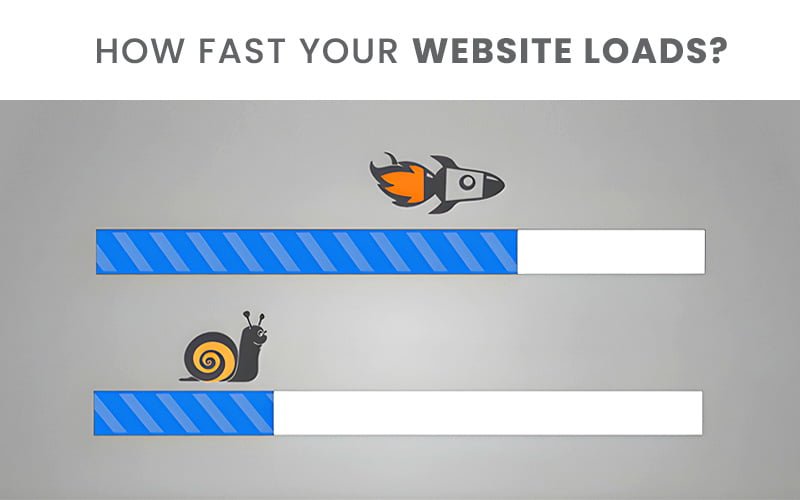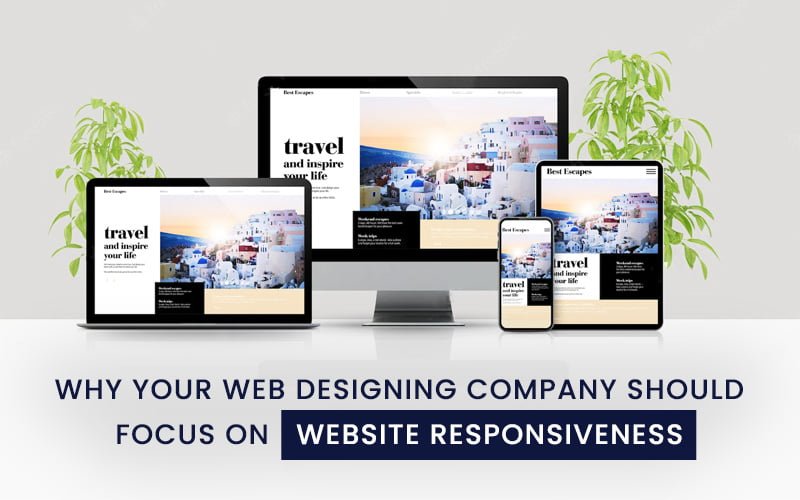In this post, we’ll define responsiveness and discuss why responsive design is so important for the Web Designing Company.
What is a Responsive Web Design?
It implies that the website’s layout or content is adaptable to the various screen sizes on which it is displayed. If you are viewing this website on a desktop, the layout may differ from that on mobile. The components, however, will be nearly identical.
A responsive website design is a web design approach that is coded to render layout properly on different screen sizes or devices. CSS Media Queries are a type of code that is used to provide responsiveness.
It enables the page to use different CSS style rules based on device size; these codes correctly paint the content layout. This approach to website responsiveness is also known as a Fluid grid system of web design.
Benefits of responsive web design.

There are numerous advantages to responsive web design. It can improve your SEO, conversion rates, user experience, and a variety of other aspects of your business that contribute to its growth.
Here are the top 10 features and benefits of responsive web design.
1. Better User Experience
A responsive website improves the user experience. The number of time users spends on your site is an important indicator of the quality of their experience. They will leave your website if they find it difficult to navigate or use because they are constantly pinching and zooming.
Visitors will have no trouble accessing menus, links, buttons, or filling out forms if your website scales and response to changes in screen size. As a result, they will have a better user experience and spend more time on your site.
Improved user experience and site usability can lead to more referrals and new customers for your online business.
2. Improvement in Mobile Traffic
According to Statista, In the second quarter of 2022, mobile devices (excluding tablets) generated 58.99 percent of global website traffic. This accounts for more than half of all Internet traffic, demonstrating the importance of responsive web design.
Begin by determining how many of your visitors come from mobile devices and how long they stay on your site. Then, put in a responsive design and compare the two figures.
When your website adapts to the viewport width, you will notice an increase in mobile visits as well as longer time spent on the site by those same visitors.
3. More swift Web Design Services
Making a separate mobile version of your site that was served when a smaller screen size was detected was once a common practice.
However, creating a mobile version of your site takes longer than creating a responsive website that looks great and works properly regardless of the device your visitors are using. And it also makes the Website Maintenance Services more simplified as they just have to deal with one version of your site and also proves to be cost-effective.
Another disadvantage of a mobile website version is that it is more expensive because your developer must create two websites instead of one.
4. No Penalty for Duplicate Content
While search engines are becoming more intelligent by the day, they still need to know which website version is more important. If you use a mobile version of your site, your content remains unchanged even if the URL changes.
Because search engines won’t know which content is relevant, both versions of your website may have lower search engine rankings. If you want both versions of your site to rank well, you must develop two separate SEO strategies and campaigns, as well as invest significantly more money in creating original and unique content for both desktop and mobile versions of your site.
5. Simplified Web Analytics
Your website stats, on the other hand, are greatly simplified with a responsive site because you’re staying on top of a single set of data. You can still see which devices and browsers your visitors are using, where they leave your site, and how long they stay, but you won’t have to read data from multiple reports to get an accurate picture.
6. Improved Website Loading Time

Responsive websites load faster on all devices, but especially on smartphones and tablets. Because of responsive images and fluid grids, a page loads much faster, which has a direct impact on the span of your user’s visit.
According to Google data, if pages take more than three seconds to load, 53 percent of mobile visitors will abandon the site. According to the same study, websites that load quickly benefit from increased time spent on the site as well as higher conversion rates. This demonstrates the significance of responsive web design.
7. Reduced Bounce Rates
Bounce rate is the percentage of visitors to a website who leave after viewing only one page. As previously stated, a responsive website means visitors will stay on your site longer, lowering your bounce rate.
You offer great content on your site but as your website is not responsive visitors bounce back can affect the overall performance of your website. Visitors will be more likely to read other pages on your site and explore everything you have to offer if your website is responsive.
8. Increased Conversion Rates
Better user experience for your visitors and trust-building measures can be started by encouraging them to spend more time on your site and lowering your bounce rate.
Better conversion rates result from improved user experience and trust, whether conversion means signing up for your newsletter, making a purchase, or scheduling a call.
9. Improved SEO
Improved search engine ranking is another advantage of responsive web design. Remember that Google is and will always be focused on the user, which is why when society shifted to a more mobile-focused web browsing journey, Google quickly adapted. In other words, Google favors SEOs who put the needs of the users before anything else.
Essentially, if you are moving toward a more mobile-optimized website, you have Google’s approval.
10. Accelerated Social Sharing
Responsive web design can boost the number of times people share your content on social media when done properly. This is yet another advantage of responsive web design. Responsive content, when combined with responsive social media buttons, makes it simple to share links to your site’s pages on smaller screens.
This can help boost your credibility and expose you to a new audience, resulting in more traffic and conversions. At the same time, social signals can have an indirect impact on your search engine rank because search engines will notice increased engagement and search demand.
Is my website responsive?
In your web browser, you can quickly determine whether a website is responsive or not.
- Launch Google Chrome.
- Visit your website.
- To open Chrome DevTools, press Ctrl + Shift + I.
- Toggle the device toolbar by pressing Ctrl + Shift + M.
- View your page from a smartphone, tablet, or desktop computer.
You can also use a free tool, such as Google’s Mobile-Friendly Test, to determine whether your website’s pages are mobile-friendly.
As the world increasingly moves toward mobile-first design, it is critical that your website development company focuses on making websites responsive. Responsive design is important for three main reasons: it helps improve the user experience, it is good for search engine optimization, and it can lead to increased sales and conversions. If you are not already focusing on responsive design, contact digital hive and make the switch today.
